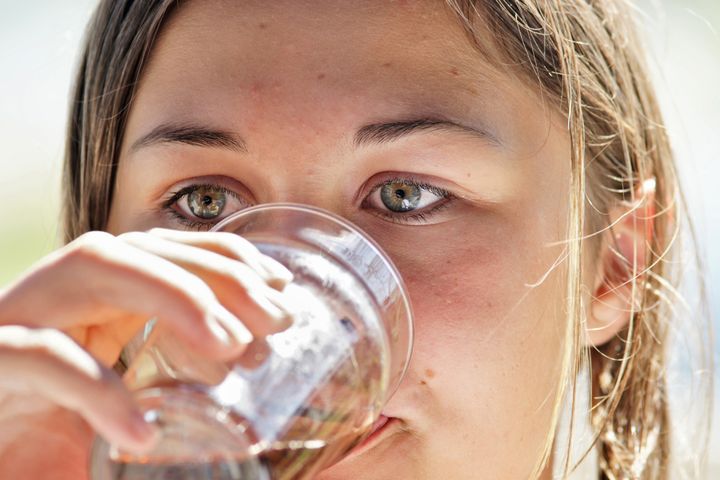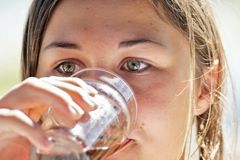New types of chemicals found in Danish drinking water

Despite a massive focus on PFAS substances and pesticide residues in Danish drinking water, little attention is paid to the hundreds of other chemical compounds in our groundwater.
Analytical chemists at the University of Copenhagen, in collaboration with Danish water and wastewater company Novafos, have taken broad measurements of substances in drinking water from three waterworks.
The researchers detected more than 400 different chemical compounds in water from a single waterworks. More than 100 compounds were found in water from each of the other two. But how many of these compounds are naturally occurring versus man-made remains unknown. At least nine of them are of particular concern to the researchers. Among other things, they can be harmful to organs and be carcinogenic and endocrine disrupting.
"Among the compounds we found were TCP, a toxic chlorinated substance used as an insecticide that can be carcinogenic, and melamine, which is used in the plastics industry and can damage the bladder and kidneys. Other compounds that can be harmful to health when in high-enough concentrations were also detected. We also measured many other chemicals that no one knows the toxicity of," says analytical chemist Selina Tisler, an assistant professor at the Department of Plant and Environmental Sciences and first author of the study, published in the journal Environmental Pollution.
As far as is known, five of the compounds detected have never before been reported in groundwater anywhere in the world. These include benzothiazole, a compound used in car tyres and on artificial turf pitches, that has shown high toxicity in cell tests. The researchers report that an additional five compounds have never been found in Danish groundwater. These include the above-mentioned TCP (2,4,6-trichlorophenol) and TFMS (trifluoromethane sulfonic acid), which are used in firefighting foams and belong to the large group of PFAS substances. A recent study shows that these cause physiological changes and disturbances in the gut bacteria of mammals.
The researchers strongly emphasize that, as for now, they only have indications of how large the concentrations of individual chemical compounds are. Therefore, no health risk can yet be established with regards to tap water consumption. According to Novafos, water from each of the three waterworks complies with all applicable regulations.
Monitoring needs to be broader
The researchers used liquid chromatography-high resolution mass spectrometry to detect a large portion of the various chemical compounds in each water sample. This technology allowed them to detect compounds that standard techniques currently used for screening groundwater are unable to detect.
According to the researchers, the major weakness in screening today is that public agencies only require monitoring for a limited number of predetermined substances.
"Taking action against PFAS substances and pesticides is definitely important. But one should also be after a broader overview of the chemicals in our environment that eventually will end up in our bodies. And, we have the techniques to help water utilities and agencies accomplish this task," says Jan H. Christensen, a professor at the Department of Plant and Environmental Sciences and the study’s lead author.
Some compounds can be treated away, but...
In many countries, groundwater destined for consumption goes through a treatment process. In Denmark, groundwater is usually just oxygenated and filtered before being pumped out to people's taps.
To study the effect of treatment, water from the three waterworks was treated using UV light (known as AOP purification), a commonly used purification technique in other countries.
The study demonstrates that treatment can make a big difference. On average, this method resulted in the removal of 70% of the chemical compounds. But at the same time, many new substances, so-called transformation products, were also formed as a result of UV light treatment. In fact, nearly as many compounds were created as the cleaning removed.
After treatment, the water from one waterworks was filtered through biological activated carbon (BAC) filters in four stages. Here, the vast majority of compounds were captured - but not all of them:
"While thorough filtration collects both the majority of newly formed compounds and some of those that were in the water from the beginning, a range of problematic compounds still slip through. These include fluorinated compounds like PFAS and PFAS-related compounds," says Selina Tisler.
Nevertheless, the two chemists believe that drinking water should be treated in Denmark. Selina Tisler points out:
"Our study demonstrates the complexity of treatment. For example, we can see that this treatment technique was effective in removing some of the pesticides, but didn’t work on PFAS compounds. So it’s important to make use of different treatment techniques depending on which substances are being prioritized for removal. Indeed, there is not necessarily one treatment process that works on all chemical compounds."
Stop using the most toxic compounds
According to Jan H. Christensen, waterworks company Novafos’ monitoring initiative is commendable:
“Initiatives like this are needed to more thoroughly measure whatever is hidden in our groundwater and learn how to best reduce the load of contaminants. It’s good to see the water utility sector being proactive and taking responsibility for ensuring clean drinking water for consumers," says Jan H. Christensen.
But he highlights that we cannot simply rely on cleansing the problem away:
"Once you have an overview of which substances are out there and in what concentrations, it can help to prioritize which wells should remain open and which should be shut, as well as which treatment technologies would be most effective. But beyond that, we need to attack the root of the problem. We need to stop using the most toxic and difficult-to-degrade compounds and thereby eliminate the source itself. And then we should not use, as often happens, alternative compounds that turn out to be just as harmful – and sometimes even more so," says Jan H. Christensen, who concludes:
"Because there are some extremely tenacious chemical compounds that are very difficult to remove from our drinking water once they get there, regardless of how and to what extent the water is treated."
FACT BOX: NINE SUBSTANCES OF CONCERN IN GROUNDWATER
- Melamine: Used in the production of hard plastics and cleaning detergents. Can damage the kidneys and bladder and is an endocrine disruptor.
- 4-chlorobenzenesulphonic acid: Suspected to be a transformation product from pesticides. May also come from industrial chemicals.
- Trifluoromethanesulfonic acid (TFMS): Also known as triflic acid, it is one of the strongest known acids. Among other things, it is used in firefighting foam. A recent study shows that the substance causes physiological changes and disturbances in the gut bacteria of mammals.
- Tris (1,3-dichloroisopropyl) phosphate (TDCPP): Used in flame retardants, pesticides, plasticizers and nerve gases. Has numerous proven harmful health effects and is an acknowledged endocrine disruptor.
- Benzothiazol-2-sulfonate: Used in rubber production – e.g., for car tyres and artificial turf pitches. Health risks are not yet known, but the compound shows high toxicity in cells.
- Pyrimidinol: Presumably a pesticide transformation product. No data on toxicity.
- 4-nitrophenol: Among other things, it is used as an insecticide and poses a serious health risk.
- 2,4,6-Trichlorophenol (TCP): Chlorinated substance used as a substitute for pesticides and in industrial products. May be carcinogenic.
- 2,5-Dichlorobenzenesulfonic acid: Suspected to be a pesticide transformation product. May also come from industrial chemicals.
FACT BOX: About the study
- The researchers measured groundwater from three waterworks on Zealand.
- They performed a so-called non-target screening using the methods supercritical fluid chromatography (SFC) and liquid chromatography (LC) connected to a high-resolution mass spectrometer (HRMS). Unlike traditional methods, this does not limit the analysis of compounds to those one expects to find, but instead screens all compounds measurable by the analytical methods selected.
- The research article for this study is published in the journal Environmental Pollution
- The study was conducted in collaboration with the Danish water and wastewater company Novafos.
- The research was conducted by Selina Tisler and Jan H. Christensen of the University of Copenhagen’s Department of Plant and Environmental Sciences and Peter L. Tüchsen from Novafos.
Keywords
Contacts
Jan H. Christensen
Professor
Department of Plant and Environmental Sciences
University of Copenhagen
jch@plen.ku.dk
+45 35 33 24 56
Selina Tisler
Assistant Professor
Department of Plant and Environmental Sciences
University of Copenhagen
seti@plen.ku.dk
+45 52 11 70 44
Maria Hornbek
Journalist
Faculty of Science
University of Copenhagen
maho@science.ku.dk
+45 22 95 42 83
Images

Links
About Københavns Universitet - Det Natur- og Biovidenskabelige Fakultet
 Københavns Universitet - Det Natur- og Biovidenskabelige Fakultet
Københavns Universitet - Det Natur- og Biovidenskabelige FakultetBülowsvej 17
1870 Frederiksberg C
35 33 28 28https://science.ku.dk/
Det Natur- og Biovidenskabelige Fakultet på Københavns Universitet – SCIENCE – er landets største naturvidenskabelige forsknings- og uddannelsesinstitution.
Fakultetets væsentligste opgave er at bidrage til løsning af de store udfordringer, som vi står overfor i en verden under hastig forandring med øget pres på bl.a. naturressourcer og markante klimaforandringer - både nationalt og globalt.
Subscribe to releases from Københavns Universitet - Det Natur- og Biovidenskabelige Fakultet
Subscribe to all the latest releases from Københavns Universitet - Det Natur- og Biovidenskabelige Fakultet by registering your e-mail address below. You can unsubscribe at any time.
Latest releases from Københavns Universitet - Det Natur- og Biovidenskabelige Fakultet
Superradiant atoms could push the boundaries of how precisely time can be measured22.4.2024 14:22:28 CEST | Pressemeddelelse
Superradiant atoms can help us measure time more precisely than ever. In a new study, researchers from the University of Copenhagen present a new method for measuring the time interval, the second, mitigating some of the limitations that today’s most advanced atomic clocks encounter. The result could have broad implications in areas such as space travel, volcanic eruptions and GPS systems.
Super-lysende atomer kan skubbe grænsen for hvor præcist vi kan måle tiden22.4.2024 14:07:32 CEST | Pressemeddelelse
Superstrålende atomer kan hjælpe os med at måle tiden mere præcist, end vi kan i dag. I et nyt studie fremlægger forskere fra Københavns Universitet nemlig en ny metode til at måle sekundet, som kommer uden om det problem, som selv de mest avancerede atomure i dag døjer med. Resultatet kan få betydning for så forskellige ting som rumfart, vulkanudbrud og vores GPS-systemer.
Verdens tundra udleder overraskende mere CO2, når det bliver varmere17.4.2024 17:00:00 CEST | Pressemeddelelse
KLAUSULERET TIL DEN 17. APRIL KL. 17:00 Når det bliver varmere, vil den arktiske tundrajord formentlig frigive 30% mere CO2, end den gør i dag. Og det er næsten fire gange mere, end hvad man tidligere har estimeret. Det viser et stort internationalt studie, som forskere fra Københavns Universitet har bidraget til, og som netop er offentliggjort i tidsskriftet Nature.
Internet can achieve quantum speed with light saved as sound15.4.2024 11:16:35 CEST | Press release
Researchers at the University of Copenhagen’s Niels Bohr Institute have developed a new way to create quantum memory: A small drum can store data sent with light in its sonic vibrations, and then forward the data with new light sources when needed again. The results demonstrate that mechanical memory for quantum data could be the strategy that paves the way for an ultra-secure internet with incredible speeds.
Internettet kan få kvantefart med lys gemt som lyd15.4.2024 10:47:07 CEST | Pressemeddelelse
Forskere ved Niels Bohr Institutet på Københavns Universitet har udviklet en ny måde at skabe såkaldt kvantehukommelse: En lille tromme kan gemme data sendt med lys i dens lydvibrationer, for siden at sende data videre med nye lyskilder, når det igen skal bruges. Resultaterne understreger at en mekanisk hukommelse for kvantedata kan være strategien, der baner vej for et ultra sikkert internet med utrolige hastigheder
In our pressroom you can read all our latest releases, find our press contacts, images, documents and other relevant information about us.
Visit our pressroom